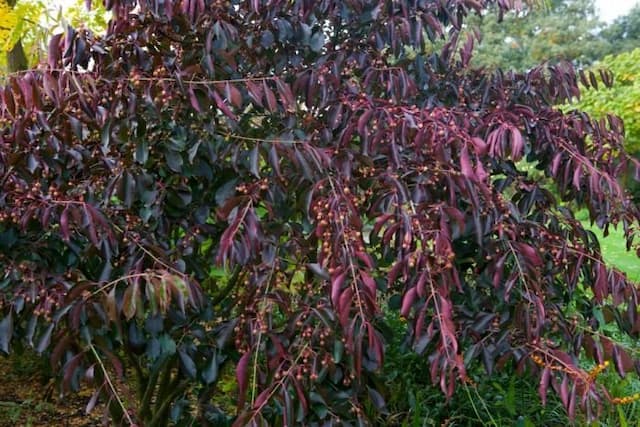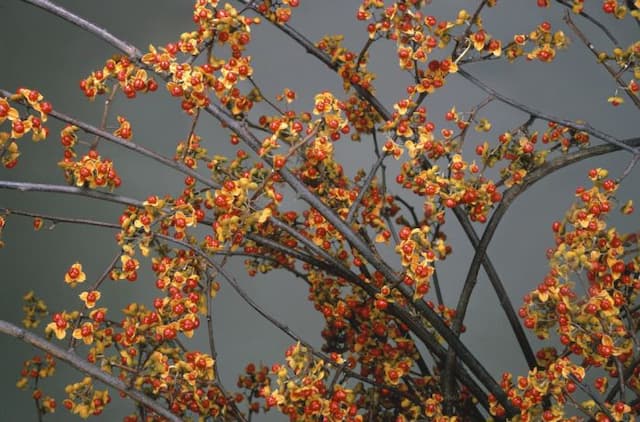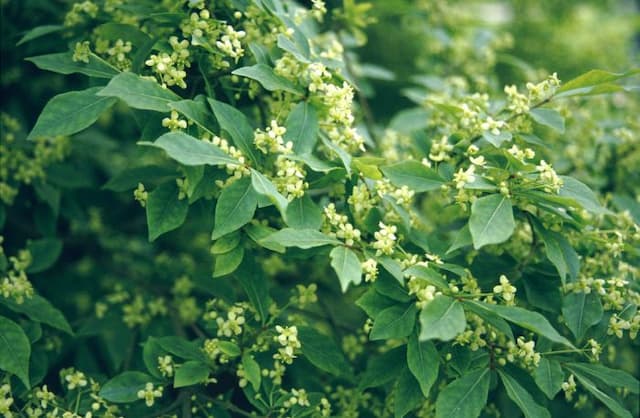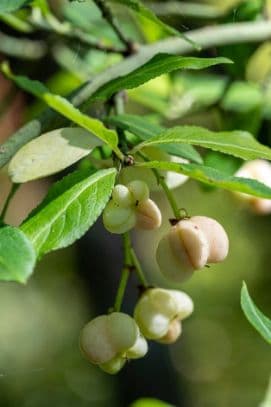Spindle 'Kewensis' Euonymus fortunei 'Kewensis'

ABOUT
'Kewensis' is a neat shrub with tiny, leathery green leaves, that can gain dark red hints in autumn, and a prostrate habit; forms a dense mat
About this plant
 Names
NamesFamily
Celastraceae.
Synonyms
Wintercreeper, Winter Creeper, Fortune's Spindle, Wintercreeper Euonymus, Kewensis Euonymus.
Common names
Euonymus fortunei 'Kewensis'.
 Characteristics
CharacteristicsLife cycle
Perennials
Foliage type
Evergreen
Color of leaves
Green
Height
1 foot (0.3 meters)
Spread
2 feet (0.6 meters)
Plant type
Shrub
Hardiness zones
5-9
Native area
China
Benefits
 General Benefits
General Benefits- Wintercreeper or Euonymus fortunei 'Kewensis' is a low-maintenance plant, requiring minimal care once established.
- It offers year-round interest due to its evergreen foliage, making it a great choice for gardeners who want consistent greenery.
- The plant has a dense growth habit, which can help with soil erosion control on slopes and banks.
- Wintercreeper provides ground cover, which can help suppress weeds and reduce garden maintenance.
- It's adaptable to a variety of soil types, from clay to sandy soils, as long as they are well-draining.
- The plant is drought-tolerant once established, making it suitable for gardens in drier climates or for xeriscaping.
- Its tolerance to a range of light conditions, from full sun to shade, makes it versatile for different garden designs and locations.
- Wintercreeper can be used in landscape designs as a border plant, creating a neat and tidy edge for garden beds and walkways.
- It's suitable for container planting, offering flexibility in garden design and the ability to move the plant as needed.
- The plant can be easily propagated from cuttings, allowing gardeners to expand their garden or share with others without additional cost.
 Medical Properties
Medical PropertiesThis plant is not used for medical purposes.
 Air-purifying Qualities
Air-purifying QualitiesThis plant is not specifically known for air purifying qualities.
 Other Uses
Other Uses- Winter Creeper foliage can be used in floral arrangements for its glossy green leaves which add texture and contrast to bouquets.
- Euonymus fortunei 'Kewensis' can serve as a living mulch, covering the soil and reducing the need for traditional wood or straw mulches.
- This plant can be trained to grow on miniature trellises in fairy gardens or other small-scale landscape projects.
- Winter Creeper can be incorporated into green roofs for its hardiness and low maintenance, helping to insulate and protect roofing materials.
- Its dense growth habit can be used to create garden topiaries or shaped hedges in formal garden design.
- Euonymus fortunei 'Kewensis' can be used in erosion control on slopes due to its dense root system stabilizing the soil.
- By trimming and shaping, the plant can be turned into a natural privacy screen or garden divider.
- The evergreen leaves of Winter Creeper can be used in crafting activities, such as creating garden wreaths or decorative displays.
- Gardeners use the textured leaf surface of the plant to create leaf casting art, often used as decorative stepping stones or garden accents.
- Clusters of Winter Creeper can be utilized in large containers or pots, providing year-round foliage as part of a balcony or patio display.
Interesting Facts
 Feng Shui
Feng ShuiThe Wintercreeper is not used in Feng Shui practice.
 Zodiac Sign Compitability
Zodiac Sign CompitabilityThe Wintercreeper is not used in astrology practice.
 Plant Symbolism
Plant Symbolism- Resilience: Euonymus fortunei 'Kewensis', commonly known as Wintercreeper, is known for its ability to thrive in a variety of conditions, symbolizing the ability to endure and adapt.
- Growth: As a fast-growing plant, Wintercreeper represents rapid expansion and the idea of quickly overcoming obstacles.
- Protection: Its dense foliage can provide cover, making it a symbol of shelter and a safe haven.
- Perseverance: The plant's evergreen nature and its capacity to stay green throughout the year symbolize steadfastness and constant effort.
- Good Fortune: With the word “fortunei” in its name, it is sometimes associated with luck and prosperity.
 Water
WaterWintercreeper should be watered thoroughly, allowing the soil to dry out slightly between waterings. Generally, it requires watering once a week, but this can vary depending on the climate and soil conditions. In hot, dry weather, you may need to water twice a week, providing approximately one gallon per watering for an established plant in the ground. Container-grown wintercreeper may require water more frequently, especially if the pot is small or in full sun. Reduce watering in the winter months when the plant is dormant.
 Light
LightWintercreeper thrives in a range of light conditions, from full sun to partial shade. The ideal location is one where the plant receives morning sunlight and afternoon shade, or dappled sunlight throughout the day. Too much intense sunlight can scorch the leaves, while too little light can result in sparse or leggy growth.
 Temperature
TemperatureWintercreeper is hardy and can tolerate a range of temperatures, from about -20 to 80 degrees Fahrenheit. It prefers moderate temperatures and performs best in the range of 60 to 70 degrees Fahrenheit. Protect the plant from extreme cold by ensuring it is planted in a sheltered location if temperatures regularly fall to the lower end of its tolerance range.
 Pruning
PruningWintercreeper can be pruned to control its size and shape and to encourage bushier growth. The best time to prune is in late winter or early spring before new growth begins. Prune as often as needed to maintain the desired form or to remove any dead or damaged branches. It can tolerate heavy pruning if required.
 Cleaning
CleaningAs needed
 Soil
SoilWintercreeper prefers well-draining soil high in organic matter, with a slightly acidic to neutral pH of about 6.0 to 7.0. A mix of peat, pine bark, and perlite or sand is ideal for ensuring good drainage and aeration while retaining adequate moisture for the roots.
 Repotting
RepottingWintercreeper should be repotted every 2 to 3 years, or when it becomes root-bound and the growth starts to slow down. It is best to repot in the spring, just before the growing season begins.
 Humidity & Misting
Humidity & MistingWintercreeper thrives in average household humidity levels, but it can also cope with lower humidity. To keep this plant happy, aim for humidity levels around 40-50%, although it is quite adaptable to varying conditions.
 Suitable locations
Suitable locationsIndoor
Place Wintercreeper in bright indirect light, water moderately.
Outdoor
Plant in well-drained soil, partial to full sun, sheltered spot.
Hardiness zone
5-9 USDA
 Life cycle
Life cycleWintercreeper 'Kewensis' begins its life cycle when a seed germinates, typically in the spring, given sufficient warmth and moisture in the soil. As the seedling emerges, it develops into a juvenile plant with characteristic small, dark green leaves. As it matures, it enters a vegetative stage, forming a ground cover or climbing vines with rooting at the nodes if it encounters a vertical surface. Throughout its adult phase, which it reaches in 2 to 5 years, it develops small, inconspicuous flowers in early summer, which are usually greenish-white. These flowers, if pollinated, give way to a fruiting stage with a small, pink to red capsule that splits open to release seeds. The plant continues its growth cycle annually, potentially living for many years, with some reports of Wintercreepers surviving for over 50 years under optimal conditions.
 Propogation
PropogationPropogation time
Spring-Early Summer
The Wintercreeper, scientifically known as Euonymus fortunei 'Kewensis', is most commonly propagated through stem cuttings. This method is usually undertaken during the late spring or early summer when the plant is actively growing. To propagate, select healthy, non-flowering shoots and cut them into sections approximately 4 to 6 inches (10 to 15 centimeters) long. Ensure each cutting has at least 2 or 3 sets of leaves. Remove the leaves from the lower half of the cutting and dip the cut end into a rooting hormone powder to encourage root development. Then, insert the cutting into a pot filled with a moistened mix of half peat and half perlite or sand, ensuring that the leafless part of the stem is buried. Finally, place the pot in a warm, bright location out of direct sunlight and keep the soil consistently moist until roots develop, which can take several weeks.





![Spindle [Blondy]](/_next/image?url=https%3A%2F%2Fplants-admin.emdemapps.com%2Fimages%2Fplants%2F%2Fimages%2F604b642f54add.png&w=640&q=75)
